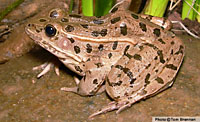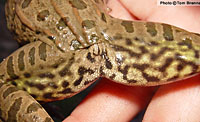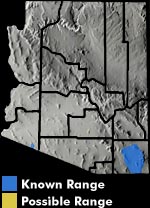Online Field Guide to The Reptiles and Amphibians of Arizona


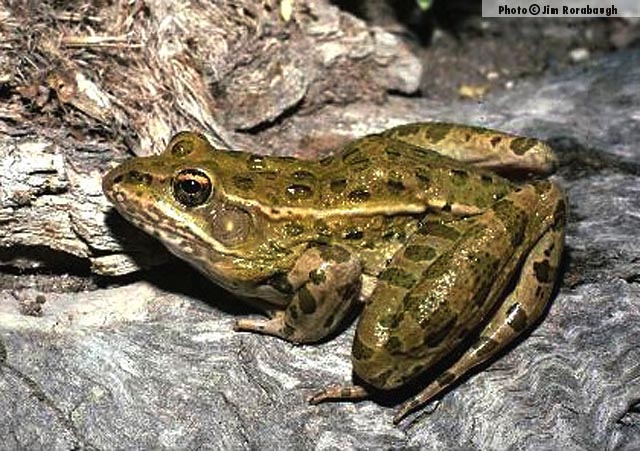
Cochise County, AZ
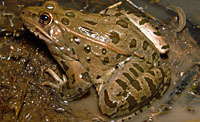 Cochise Co., AZ |
| PLAINS LEOPARD FROG Lithobates blairi | |
|
DESCRIPTION: This leopard frog grows to about 4.4 inches in length; males average a smaller size than females. This is a buff, pale brown, or olive green frog with dark spots. It is distinguished from other Arizona leopard frogs by a combination of characters, including incomplete dorsolateral folds that are broken and inset towards the rear, usually a white spot in the center of the tympanum, a complete lip or supralabial stripe, typically a spot on the snout in front of the eyes, and a reticulation of dark and light on the rear of the thighs that is more open and lighter in color than either the Rio Grande or lowland leopard frog. The tadpoles are relatively pale and uniform in color and may reach >3 inches total length. DISTRIBUTION: In Arizona, the plains leopard frog is historically known from the Sulphur Springs Valley and the adjoining bajadas or lower canyons of the Chiricahua and Dragoon mountains, Cochise County, where it occurred in cattle tanks, irrigation sumps, streams, and settling ponds at a power plant. It has declined substantially since the 1970s. Most observations in recent years are from two areas in the western part of the valley. The Arizona populations of the plains leopard frog are disjunct from other Lithobates blairi; the next nearest known populations are about 200 miles east in the Rio Grande valley. A single record exists for the species from Ashurst Lake southeast of Flagstaff, which may represent an introduction. HABITAT: In Arizona, it is now primarily a frog of stock tanks, other man-made waters, and sloughs. It historically occurred along streams draining the western slopes of the Chiricahua Mountains. BEHAVIOR: Can be found active day or night, although they are easier to find and observe at night with a headlamp or flashlight. Probably moves considerable distances overland and along drainages during summer monsoons, when it can occasionally be found on roads at night. DIET: The plains leopard frog feeds upon a variety of invertebrates as well as some vertebrates (a bat was documented in the diet of a Texas specimen). REPRODUCTION AND CALLS: In Arizona, plains leopard frogs breed from late March through early June, and from August through October. Egg masses contain up to 6,500 eggs and are usually attached to vegetation in shallow water. Tadpoles are known to overwinter. The call is a stuttering chuckle call, similar to the lowland leopard frog. REMARKS: Causes of decline are unclear, but likely include predation by non-native predators. By Jim Rorabaugh PROTECTED Clarkson, R.W., and J.C. Rorabaugh. 1989. Status of leopard frogs (Rana pipiens Complex) in Arizona and southeastern California. Southwestern Naturalist 34(4):531-538. Degenhardt, W.G., C.W. Painter, and A.H. Price. 1996. Amphibians and Reptiles of New Mexico. University of New Mexico Press, Albuquerque. Crawford, J.A., L.E. Brown, and C.W. Painter. 2005. Rana blairi Mecham, Littlejohn, Oldham, Brown, and Brown, 1973, Plains leopard frog. Pages 532-534 in M.J. Lannoo (ed), Amphibian Declines: The Conservation Status of United States Species. University of California Press, Berkeley.Stebbins, R.C. 2003. A Field Guide to Western Reptiles and Amphibians, Third Edition. Houghton Mifflin Company, Boston, MA. |
|
Visit Partners in Amphibian and Reptile Conservation:


HOME
Copyright © 2023, Arizona Game and Fish Department. All rights reserved.
If you make use of the textual contents of this site in reports, publications, etc. please cite and credit the author(s) and photographer(s). All photos on this website are copyrighted. However, those found in the species account section may be used for any noncommercial scientific, educational, or conservation purposes provided that photographs are not altered and continue to bear the copyright symbol and name of the photographer. Please contact the photographer regarding commercial use of copyrighted photographs.










